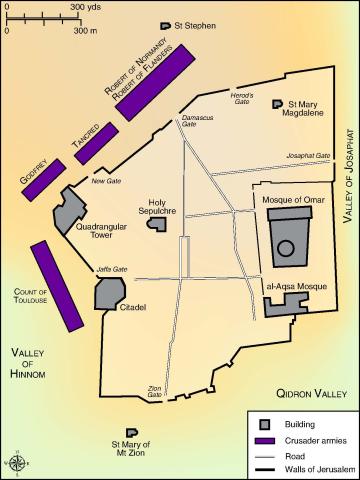The Siege of Jerusalem
[10.38.3] At Raimundus comes ā merīdiē condūxit suum exercitum et castellum usque prope mūrum, sed inter castellum et mūrum erat quaedam fovea nimis profunda. Tunc cōnsiliātī sunt nostrī ut implērent foveam, fēcēruntque praecōnārī, ut sī aliquis in illam foveam portāsset trēs petrās, ūnum habēret dēnārium. Perdūrāvit vērō haec implētiō per trēs diēs et noctēs. Tandem, plēnā foveā, condūxērunt castellum iuxtā mūrum. Illī autem quī intus erant mīrābiliter proeliābantur cum nostrīs, igne et lapidibus. Audiēns itaque comes quod Francī essent in urbe, suīs dīxit hominibus: “Quid tardātis? Ecce omnēs Francigenae iam sunt in urbe.”
notes
(July 1098) Attacking from the south (really south west), Raymond of Toulouse pays people to fill the ditch between the wall and his siege tower. He then attacks, but meets fierce resistance, until he learns that other crusaders have broken into the city, and he tells his men not to be so slow.
ā merīdiē: "from the south."
condūxit: CL would presumably be conduxerat; the events described must have taken place before the assault on Friday.
castellum: his siege tower.
Perdūrāvit vērō haec implētiō per trēs diēs et noctēs: i.e., Tuesday to Thursday.
vocabulary
merīdiēs merīdiēī, m.: the south (the location of the sun at midday)
fovea –ae, f.: a small pit

